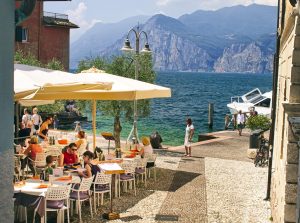Kazakhstan and the South Caucasus corridor in the wake of the Georgia-Russia War

Download “Kazakhstan and the South Caucasus corridor in the wake of the Georgia-Russia War”
EUCAM-Policy-Brief-3.pdf – Downloaded 492 times – 485.19 KBThe Baku-Tbilisi-Ceyhan (BTC) oil pipeline links Azerbaijan and Georgia to European energy markets, establishing the basis for their geopolitical reorientation of recent years. These two countries also created the South Caucasus transit corridor for resourcerich Central Asian states. Kazakhstan has slowly but surely worked to develop this westbound route for its oil exports. It has been building port facilities on its side of the Caspian, bought tanker ships and acquired a terminal in Georgia. The August war between Georgia and Russia revealed the insecurity of transit through Georgia and reminded us of the fragile stability of the region of South Caucasus. It seemed to put Kazakhstan’s plans of ’going west’ in jeopardy. However, developments that took place this autumn show that Astana is not ready to give up the South Caucasus route, which is highly important for commercial and geopolitical reasons.
1. The South Caucasus corridor – an alternative route to Europe
Kazakhstan’s ambitions for more substantial sovereignty have been fuelled by its rich oil and gas reserves. They put the country on the map of major players, attract investments, create economic growth and allow it to create new partnerships through the diversification of export routes. Whereas at the beginning of Kazakhstan’s independence, all of its oil was transported to Russia, a decade and a half later, about 80% of its oil goes into the Russian pipeline system, and the rest – to China via the newly built pipeline Atasu-Alashankou, across the Caspian Sea to Azerbaijan, and to the Iranian port of Neka.
Kazakhstan has been exploring export routes in all directions, but the westbound routes stand out. They are commercially attractive and receive political support of the US and European governments. Importantly, they are in line with the national interest of Kazakhstan, for they promote its bargaining positions against Russia and provide opportunities for partnerships with the West.
Kazakhstan started small shipments of oil across the Caspian from its port of Aktau in the late 1990s. In 1998 it created the national shipping company KazMorTransFlot (Kazakhstan Sea Transportation Fleet), and since then has been developing its capacity. The company acquired three tankers (“Aktau”, “Astana” and “Almaty”) each with a capacity of 12 deadweight tonnes, three towboats and eight site barges.(1) It operates from the port of Aktau. The main shipping routes for Kazakstani crude have been Aktau- Baku, Aktau-Mahachkala (Russia) and Aktau-Neka.
Between 1998 and 2002, the Aktau-Baku route was used to transport crude from the Tengiz oil field. It was shipped to the Azerbaijani port of Sangachal, 45 km south of Baku, and from there by rail to the Georgian port of Batumi. The shipping was suspended when the Caspian Pipeline Consortium (CPC) pipeline connecting the Tengiz oil field with Novorossiysk, the Russian port in the Black Sea, was put into operation. However, it resumed again in October 2008, when it became clear that the CPC would not be enlarged to keep up with the growing production at Tengiz.
The route is also used to transport oil from the Kumkol field located in the south-east of Kazakhstan. At present, the terminal at Aktau is shipping 9-10 million tonnes of oil annually, of which 2-2.4 million tonnes are destined for the Black Sea ports of Batumi, Poti and Kulevi.(2)
New opportunities emerged with the construction of the BTC pipeline, which could transport Azerbaijani and Kazakhstani oil to the Turkish port of Ceyhan. The inauguration ceremony took place in July 2006, and in the previous month the presidents of Kazakhstan and Azerbaijan signed a framework agreement to transport Kazakhstani oil via the BTC, starting with 7 million tonnes a year and raising the volume to 20 million tonnes. Kazakhstani oil was to help fill the BTC to its full capacity of 50 million tonnes a year. The consortium was counting on volumes of Tengiz oil and Kashagan oil, once this giant field gets on line.
In January 2007, the national oil and gas company KazMunaiGaz (KMG), participants in the international consortium Agip KCO developing the Kashagan field, and Tengizchevroil agreed to set up Kazakhstan Caspian Transport System (KCTS) to transport hydrocarbons to world markets (via the Black, Mediterranean and Baltic Seas). According to the plan, the KCST would initially transport 25 million tonnes of oil annually to be increased to 38 million tonnes. The launch of the system is planned to coincide with the start of production at the Kashagan field (according to the latest agreement between the government of Kazakhstan and the consortium, this will take place in 2013). The estimated cost of the KCTS is $3 billion.(3)
As part of the KCTS, it is planned to build a pipeline that would connect the onshore terminal for Kashagan oil in Eskene with the port of Kuryk (76 km south of Aktau), and also equip Kuryk with an oil terminal capable of receiving large-capacity tankers. The project was developed by KMG, its daughter-company KazTransOil and the French company Total. The envisioned initial capacity of Eskene- Kuryk pipeline is 23 million tonnes a year, with possible enhancement to 35-56 million tonnes.(4)
The KCTS project revealed the ambitions held by Kazakhstan with regard to the Caspian export routes and the country’s role in world energy markets. Due to years of high oil prices, Kazakhstani companies had the money to support these ambitions. They started acquiring infrastructure assets abroad.
In August 2007, KMG acquired 75% of Romanian Rompetrol for $2.7 billion. The deal doubled KMG’s refining capacity and gave access to 630 petrol stations across Europe. In the words of the KMG president, it provided the company with “a footprint in important downstream markets in Europe, including France, Romania, Moldova and Bulgaria, as well as the ability to utilize Rompetrol as a platform for future expansion.”(5)
In February 2008, KMG became the sole owner of the Batumi port and oil terminal. The acquisition allows KMG to be more in control of Caspian transportation routes and to compete in this area with its Azerbaijani counterpart. The annual transshipment capacity of the Batumi terminal is over 15 million tonnes.
It is worth mentioning that Georgia became one of the main recipients of Kazakhstani investments abroad. According to the Georgian Ministry of Foreign Affairs website, in 2006 Kazakhstan invested $185.7 million in its country. There is no official statistics for subsequent years, but it is reported that by 2008 its investments in Georgia reached $2 billion, mainly in energy, construction, banking and telecommunications. At present, Kazakhstan is the thirdlargest investor in Georgia.(6)
The South Caucasus corridor has also been considered for transporting Kazakhstan’s gas to European markets. KMG enlists the Transcaspian gas pipeline (that would connect Aktau with Baku) and use of the South Caucasus gas infrastructure among the potential routes for produced gas. At present, Kazakhstan’s government officially states that it does not exclude the possibility of westbound routes for its gas. However, Russia-bound gas pipeline projects seem to have more substance, and the Kazakhstan part of the Central Asia-China gas pipeline (that will carry 30 bcm of Turkmen gas via Uzbekistan and Kazakhstan to Chinese Xinjiang) is already under construction.
According to the calculations of Shamil Yenikeyeff of the Oxford Institute for Energy Studies, Kazakhstan might produce around 30 bcm of gas for sale by 2015, out of which around 18-20 bcm will be available for export (the rest will satisfy the growing domestic consumption). Of this total, around 15 bcm will be sold to Russia, in line with preliminary agreements, and 5 bcm will go to China.(7) Importantly, Kazakhstan-China gas pipeline projects enhance domestic energy security, bringing gas to the energy-thirsty south of the country, dependent on imports from Uzbekistan. Some gas might go to the EU bypassing Russia, if the Transcaspian gas pipeline and Nabucco or Nabucco-like pipeline materialise.
Therefore, Kazakhstan can eventually export its gas via the South Caucasus energy corridor, but it seems unlikely to assume the role of the promoter of westbound pipeline projects. Azerbaijan and Turkmenistan would have to take the lead.
The 1998-2008 decade has been marked by active efforts on behalf of Kazakhstan to develop its energy production potential and to create infrastructure for export of hydrocarbons to external markets, especially to the lucrative European ones. Kazakhstani companies made major investments in the Caspian transportation routes and planned to expand operations into the Black, Mediterranean and Baltic Seas. The Georgia-Russia war that broke out in August 2008 could shake these plans.
2. Kazakhstan’s reaction to the Georgia-Russia war and post-war developments
The Georgia-Russia war became a source of major dilemmas for Astana. On the one hand, Kazakhstan, as Russia’s closest strategic partner, was to support Moscow. On the other, Russian actions endangered the westbound export route for Kazakhstani oil and Kazakhstani investments in Georgia. The South Caucasus corridor to Europe was suddenly closing up. The subsequent recognition by Russia of separatist Abkhazia and South Ossetia as independent states also hit the nerve of Kazakhstani leadership, which was carefully watching for any threats and challenges to Kazakhstan’s territorial integrity.(8) In addition, such recognition would discredit Kazakhstan in the eyes of the West on the eve of its OSCE chairmanship in 2010. The EU specifically asked the Kazakhstani government not to recognise Abkhazia and South Ossetia.
The first official reaction of Kazakhstan came during the Olympics in China. President Nazarbayev, who attended the Games, met Prime Minister Putin and publicly criticised Georgia for resorting to force and failing to consult other CIS members, thus giving support to Russia’s position. At the same time Nazarbayev emphasised the necessity of using diplomatic means and solving the problem in the framework of international law. Later at the Collective Security Treaty Organization summit, Kazakhstan together with other members stated that they are “deeply concerned by Georgia’s attempt to use force in order to resolve the conflict in South Ossetia” and called on other states to have a “balanced and objective, devoid of double standards, assessment of the situation in the Caucasus.” The also supported “Russia’s active role in the provision of peace and cooperation in the region.” However, no promises were made to recognise South Ossetia and Abkhazia. A similarly lukewarm statement of support was given by the member states of the Shanghai Cooperation Organization in late September.
The war did not damage the energy transport infrastructure, but changed the risk assessments.(9) In August, at the height of the conflict, Kazakhstan suspended oil shipments through Batumi. The flows, however, were resumed in September. Also in September Astana announced that it is dropping its plans to build a grain terminal in the Georgian port of Poti due to “the current situation in Georgia”. The same week KMG announced the suspension of the oil refinery project in Batumi, claiming that the decision was based purely on economic reasons.(10)
Subsequent developments show that the Georgia-Russia conflict impeded Kazakhstan’s expansion plans but did not halt them. In October TengizChevroil signed an agreement with the BTC pipeline company (Chevron holds a minority share in it) to increase the input of Tengiz oil into that pipeline. It is reported that it will start with 1-3 million tonnes and will gradually increase the volume to 5 million tonnes.(11)
Also in October Kazmortransflot developed a strategy for 2008-2012. Its main goal is to develop transport corridors in the Caspian Sea and further integration into the transportation in the Black, Mediterranean and Baltic Seas and also in the Persian Gulf. It plans to participate in projects of transportation of LPG (liquified petroleum gas) and LNG (liquified natural gas) and sulphur. To support these operations, Kazmortransflot is planning to buy or build in 2009-10 five oil tankers, each with a deadweight of 12 tonnes, and a number of smaller boats.(12)
In November, at the Baku energy summit (a follow-up to Krakow, Vilnius and Kyiv energy summits), KMG and the Azerbaijani national oil and gas company SOCAR agreed on the basic principles of a joint project to bring Kazakh oil across the Caspian Sea to world markets from 2012. Output will be shipped to Baku and then through either the BTC pipeline or across the Black Sea. The project envisages loading terminals on the Kazakhstan Caspian coast, tankers, off-loading terminals on the Azeri coast and linking facilities to the BTC pipeline.(13)
3. Prospects of developing Kazakhstan-South Caucasus energy routes
In Baku, Kazakhstani representatives signed an agreement with SOCAR, but did not sign the final declaration of the summit that stated the importance of alternative export routes and support for existing and planned Westernbacked pipelines. Astana prefers to avoid any activities of symbolic value when it comes to westbound routes in order not to antagonise Russia.
Russian perceptions and interests are seriously taken into account by Kazakhstani policy-makers. Kazakhstan positions itself as a strategic partner of Russia and a core member of Russian integration initiatives. However, Moscow’s tendency to use its energy companies and transport systems for broader political goals and its heavyhanded ways to reach those goals are not appreciated. For years Kazakhstan has been promoting the increase in the capacity of the CPC to 67 million tonnes a year (in 2007, it pumped 32.6 million tonnes) to transport oil from Tengiz and eventually from Kashagan, but Russia was too determined to control the pipeline and stalled these efforts. Ironically, this pushed Kazakhstan to develop the KTCS, which is economically inferior to the enlarged CPC. Once the Transcaspian route became more realistic, Russia decided to support the CPC enlargement in fear of losing competition to the BTC.(14)
According to the Memorandum signed by CPC shareholders, the enlargement will be completed by 2013. It is estimated that it will cost $3-3.5 billion, and it is decided to raise the money among members of the consortium (Russia has a 31% share, and Kazakhstan 19%).(15) Considering the economic crises in Russia and Kazakhstan, the fact that the consortium is already saddled with a $5 billion debt, and the customarily hard decision-making process among the members, this plan might prove to be too optimistic. As discussed above, the alternative KCTS project is already going forward and has much better chances to be completed on time.
The South Caucasus corridor is an attractive option for Kazakhstan, but its use can be constrained by a number of factors, mostly of a political nature. The key ones are the security situation in the Caucasus and relations between Russia and the West. These factors are interlinked. If the Russia-Georgia conflict is re-kindled, or a war over Nagorno- Karabakh breaks out, Kazakhstan would have to do some hard thinking about other options for transportation of its oil. If Russia and the West (the US and the EU) do not find some form of accommodation of each other’s interests, that would also make it increasingly hard for Kazakhstan to pursue its ‘multi-vector’ energy diplomacy.
Considering that Kazakhstan is suffering from an economic crisis and the fact that the oil and gas markets are volatile at the moment, the economic factor should also be taken into account. So far, however, as already mentioned, Kazakhstan has not given up on developing the trans-Caspian energy transport infrastructure. It will need outlets for the output from its largest oil fields (Tengiz and Kashagan).
As for transporting Kazakhstani gas across the Caspian, the prospects look vague at the moment. If the EU pushes for the development of the Southern Gas Corridor (bringing gas from the Caspian region and the Middle East to Europe), which was indicated as a priority in the Second Strategic Energy Review, Kazakhstan might join in as a secondary player.(16) The ongoing (January 2009) Russia-Ukraine gas crisis shows again that Moscow mixes politics with business to the detriment of both. It would give an additional impetus to the EU to diversify gas supplies.
The Southern Gas corridor is in the interests of European consumers, producers in the Middle East (Iran, Iraq and Egypt) and the Caspian region (Azerbaijan, Turkmenistan, and possibly Kazakhstan and Uzbekistan), and the transit countries (Turkey and Georgia). Therefore it has a good chance to be realised, but it will take time, patience and consistent effort.
Russia has been pushing for its own alternative gas pipeline routes, first of all the North Stream and the South Stream. However, these projects ran into major difficulties. In the opinion of Vladimir Milov and Boris Nemtsov, both the North Stream and the South Stream are examples of ‘adventurism’ and lack a thought-out strategy. They argue that these projects are excessively expensive, and very importantly, that Gazprom’s falling production would not allow Russia to fill these pipelines.17 They become even more problematic under the conditions of financial and economic crisis in Russia. The EU has a more grounded approach and significantly better resources (financial, technical and institutional) to support its projects.
The Russia-Georgia conflict revealed how difficult it is becoming for Kazakhstan to maintain its balancing act, but it can also make good use of the situation. On 3 September 2008, after meeting German President Horst Kohler, President Nazarbayev said that Kazakhstan is ready to participate in the negotiations around the situation in South Ossetia. Considering Kazakhstan’s good relations with Russia, Georgia and the EU, it can play a positive role in resolving the conflict and raise its own credentials on the eve of the OSCE chairmanship.
Both the EU and Kazakhstan are keenly interested in the peace and stability of the South Caucasus for many reasons, including those related to energy security. Both are trying to be good partners for Russia. Another actor with a similar approach is Turkey. Ankara has been very active in the wake of the Georgia-Russia crisis, trying to find a new formula for stability in the South Caucasus. One Turkish proposal is to keep outsiders away from the affairs of the region. Needless to say, this approach could only be supported by Moscow.(18)
The fog of war has not entirely lifted. So far, Kazakhstan has decided to continue developing the Caspian export routes. However, this effort can be fully-fledged only if the security situation in the Caucasus improves and the sides find some kind of mutually beneficial arrangement. The EU and Kazakhstan should push for a win-win arrangement in the South Caucasus, taking into account Russia’s heightened sensitivity and pride. Although this is much easier said than done, the task deserves a major effort as the consequences of the other scenario can be too damaging for all sides.
Conclusions
- Westbound oil and gas export routes are in line with the national interest of Kazakhstan, for they give access to lucrative European markets. They also promote the country’s bargaining positions against Russia and provide opportunities for partnerships with the West. The South Caucasus energy corridor plays a special role in this regard. It allows transporting Kazakhstan’s oil and potentially gas to Europe bypassing Russia.
- The CPC pipeline that brings Kazakhstan’s oil to the west via Russia cannot accommodate the increase in production. The planned enlargement had been stalled for a long time due to Russian resistance driven by the Kremlin’s determination to control the pipeline. The Kazakhstani government and Tengiz and Kashagan producers, frustrated by a lack of progress, turned to the Trancaspian option. In 2007, Kazakhstan launched the KCTS – creating the infrastructure to transport its oil across the sea to Azerbaijan by tankers and barges. The KMG started buying assets in the Black Sea to acquire access to European markets.
- Apart from agreements with Azerbaijan, Kazakhstan’s government was promoting investments in Georgia, primarily into the energy, construction and telecommunications sectors. It became the third largest investor in Georgia and developed very good relations with Tiblisi. This placed Kazakhstan in a difficult position when the Georgia-Russia conflict broke out in August 2008. Not only did Astana have to resist the pressure from Moscow to recognise South Ossetia and Abkhazia (which Kazakhstan sees as contradictory to its national interest), but also worry about the investments in the Transcaspian route and Georgia. On the other hand, good relations with both Russia and Georgia, creates opportunities for mediation efforts by Kazakhstan. That would give some badly needed points to Kazakhstan’s chairmanship of the OSCE in 2010.
- The Georgia-Russia war exposed the fragile security of the South Caucasus energy corridor. So far, Kazakhstan has decided to proceed with development of the Transcaspian route. If the conflict between Russia and Georgia is re-kindled, or a war over Nagorno-Karabakh breaks out, Kazakhstan would have to re-think its oil transportation options. That would also rule out the potential use of the South Caucasus corridor for export of Kazakhstani gas.
- The Georgia-Russia war also revealed how increasingly difficult it is becoming for Kazakhstan to navigate between a more assertive Russia and the West. If Russia and the West (the US and the EU) drift more apart, that would also make it increasingly hard for Kazakhstan to pursue its ‘multi-vector’ energy diplomacy.
- Turkey is willing and able to contribute to the settlement of the conflict and improvement of regional security in the South Caucasus. Ankara’s interests are in line with those of the EU and Kazakhstan, and it also tries to find an accommodation with Russia.
- All parties should tread softly. At the same time, a certain level of determination to go ahead with energy projects is necessary. The EU has significantly more resources (financial, technical and institutional) at its disposal than Russia, and therefore can provide better support for its projects.
- Both the EU and Kazakhstan have a deep interest in the development of the South Caucasus corridor. The resulting infrastructure and linkages created will not only satisfy the needs of the producers, transit states and consumers, but they will also help to promote better relations and more security in the region.
- Of particular importance for the EU is the possibility of transporting Central Asian gas to Europe as part of the planned and prioritised Southern gas corridor. It has a good chance to be realised but will require time, effort and patience. Kazakhstan can eventually become a supplier of gas to Europe, which will be mutually beneficial.
- For an excellent overview of Kazakh-stan’s Caspian transport infrastructure, see Farid Guliyev and Nozima Akharrkhod-jaeva, Transportation of Kazakhstani Oil via the Caspian Sea. Arrangements, Actors and Interests, RussCasp Working Paper, 18 November 2008.
- Ibid., p. 12.
- Vladimir Sokor, “Azerbaijan-Georgia Corridor: Growing Transit Volumes Bolster Security”, Eurasia Daily Monitor, Vol. 5, No. 221, 18 November 2008.
- Interview with Berik Tolumbayev, General-Director of KazTransOil, Oil and Gas of Kazakhstan, Vol. 2, 2007.
- Market Watch, 27 August 2007 (http://www.marketwatch.com/news/story/kazakh-oil-firm-buys-75/story.aspx?guid=%7BACEA6EEA-70A1-4432-AB64-B33730BE5838%7D).
- Ustina Markus, Kazakhstan: Investor Status, 20 October 2008, (http://isn.ethz.ch/isn/Current-Affairs/Security-Watch/Detail/?Ing=en&id=92917).
- Shamil Midkhatovich Yenikeyeff, “Kazakhstan’s Gas: Export Markets and Export Routes”, Oxford Institute for Energy Studies, November 2008.
- As a young country with a multi-ethnic population, Kazakhstan is vitally interested in the maintenance of the principle of territorial integrity. Fears of Russian separatism in the north of the country that were strong in early 1990s have subsided but have not been fully eliminated.
- The BTC pipeline was temporarily out of operation in August. Interestingly, it happened not due to the war, but because of an explosion in the Turkish part of the pipeline on August 5.
- SRI, “Analysis: Is Kazakhstan Disengaging from Georgia?”, 16 October 2008, (http://silkroadintelligencer.com/2008/10/16/is-kazakhstan-disengaging-from-georgia/)
- Reuters, 10 October 2008 (http://www.reuters.com/article/companyNewsAndPR/idUSLA52434520081010).
- Panorama, 3 October 2008.
- Panorama, 21 November 2008.
- IA Regnum, 27 November 2008 (http://www.regnum.ru/news/1090099.html).
- In December 2008, KMG reached an agreement to buy BP’s share of Kazakhstan Pipeline Ventures LLC (KPV), with 1.75% share in CPC, and is looking into the possibility of acquiring half of Oman’s 7% share sold to Russia, which might be difficult due to the ongoing financial crisis. Kazakhstan is trying to maintain a certain balance of power in the consortium.
- The Second Strategic Energy Review. An EU Energy Security and Solidarity Action Plan, November 2008 (http://ec.europa.eu/energy/strategies/2008/doc/2008_11_ser2/strategic_energy_review_communication.pdf).
- Boris Nemtsov and Vladimir Milov, Putin and Gazprom (in Russian), Moscow, 2008, pp. 20-23.
- Igor Torbakov, “The Georgia Crisis and Russia-Turkey Relations”, Jamestown Foundation, 26 November 2008 (http://www.jamestown.org/uploads/media/Torbakov_Russia_Turkey.pdf).







